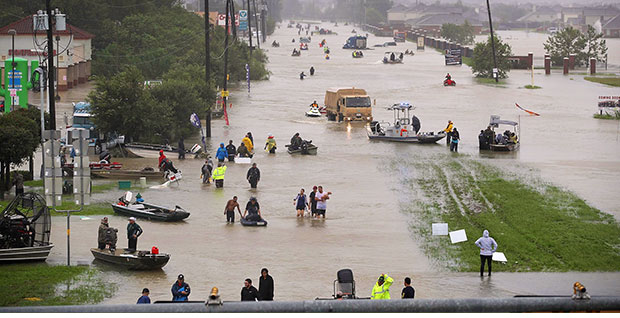College profs analyze Harvey flooding in print, on radio, TV

Philip Berke

Sam Brody

Shannon Van Zandt
As Harvey’s record-setting rainfall inundated wide swaths of coastal Texas, expert researchers in natural disaster planning, recovery and sustainability at the Texas A&M College of Architecture, in penned columns and numerous interviews with print, TV and radio journalists, described how land development practices exacerbated the flooding and prescribed actions to mitigate flood damage in the future.
Unbridled growth contributed to flooding
In a BBC-commissioned piece, Phil Berke, professor of urban planning and director of the Texas A&M Institute for Sustainable Communities, said the loss of wetlands and other results of rapid, but poorly planned growth explains Houston's increasing flood vulnerability.
“Growth itself is not a problem, as it can create economic, social and environmental benefits for cities,” he said. “But poorly planned growth which fails to carefully manage land use — for housing, businesses and the infrastructure like roads, parks and sewers that cities need — can create problems and even lead to disasters.”
For the region to thrive in the coming century, Berke continued, better coordinated planning decisions between federal, state and local government entities is sorely needed.
Berke also provided examples of policies adopted by other cities that could help Houston reduce its flood vulnerability.
“Faced with coastal storms and rising sea levels on the Atlantic coast, Norfolk, Va, has adopted long-term strategies for guiding future land use and development,” he said. “For example, areas at low risk of flooding where there has so far been limited development will be transformed into high density and mixed-income neighborhoods.”
In high-risk areas, he said, city plans call for buyouts to distance housing in established areas from shorelines, and maintaining, but not expanding, sewer and water lines.
Read article: " [Why is Houston so vulnerable to devastating floods?] (http://www.bbc.com/news/world-us-canada-41107049) "
An emphasis on disaster protection
The current practice of landscape-altering development put tens of thousands of people in harm’s way, Sam Brody, professor of urban planning, told HBO’s Vice News Tonight in a segment airing Sept. 6, 2017.
“I don’t think you can put the blame on one agency or individual. It’s a collection of factors working together,” said Brody, who has a joint appointment to the Department of Marine Sciences at Texas A&M University at Galveston, where he holds the George P. Mitchell ’40 Endowed Chair in Sustainable Coasts and directs the Center for Texas Beaches and Shores.
The time is now, he said, for the region to make a fundamental change in the way it conceives and acts upon flood risk.
“We need to go beyond recovery and fundamentally start changing the way we’re dealing with these problems and move away from recovery, more towards protection.”
Brody’s concerns were detailed in the March 3, 2016 Texas Tribune-Pro Publica report “
[Hell and High Water]
(https://projects.propublica.org/houston/)
” which went on to earn its authors an Edward R. Murrow Award for investigative reporting.
Planning before disaster strikes
In a Sept. 3, 2017 San Antonio Express-News editorial, Shannon Van Zandt championed the importance of communities, builders, engineers, architects and caseworkers collaborating to establish a housing recovery program before a natural disaster strikes.
“Prerecovery planning enhances resilience by mitigating population displacement, maintaining social networks, speeding recovery and rebuilding, and providing cost-effective solutions. Importantly, it also engages community stakeholders in developing a vision for the future of their community,” she said.
She and an array of housing advocates are lobbying for new laws to enable such efforts across the state.
In 2015 and 2017 legislative sessions, Van Zandt testified in legislative committee hearings in support of prerecovery planning bills, which have garnered bipartisan support but have yet to reach the governor’s desk.
“So, again, we find ourselves no better prepared to take on a natural disaster like Hurricane Harvey than we were when Hurricane Ike struck Galveston nine years ago,” she said. “As a result, people are suffering, property is being damaged, and local governments, local businesses and the state of Texas are losing money and will require outside help to recover.”
Read Van Zandt’s editorial: “
[A better way to speed recovery from Harvey]
(http://m.mysanantonio.com/opinion/commentary/article/A-better-way-to-speed-recovery-from-Harvey-12168054.php)
."
Low-income residents fare worse in disasters
Another step Houston and Harris County can take to increase their flood resilience is to stop allowing housing and commercial developments in low, flood-vulnerable areas, said Berke in a Fast Company article by Adele Peters.
These are areas, Van Zandt said in the same article, where low income housing is often located.
“One of the findings that is most robust in the disaster literature is that low-income families and families of color will receive a greater degree of damage to begin with,” she said. Recovery, research shows, can take two to four times longer for low-income families or families of color than for other households.
The Houston region, said Berke, should be more proactive in identifying where development should happen, building up green infrastructure, and considering more creative approaches, like innovative storm water runoff measures undertaken in Rotterdam, The Netherlands, 90% of which lies below sea level.
Read the Adele Peters’ article: “
[How Houston Can Become More Resilient To Future Floods]
(https://www.fastcompany.com/40459626/how-houston-can-become-more-resilient-to-future-floods)
.”
Harvey could spur lasting land use changes
Since Harvey’s rains affected so many areas of Houston, the region might finally approach land development more intelligently, said Van Zandt in a Washington Post opinion piece by Jonathan Katz.
“I hate to say it, but I think that because not just low-income people have been affected, there may be more of a reaction from middle- and upper-income folks,” she said.
In the meantime, she said, low-income households will struggle to recover.
“They lack a lot of resources,” she said, including insurance, especially flood insurance, which the poor are less likely to have, as well as information and social resources that help them access assistance.
The key, she added, is for people to understand that a disaster like Harvey is in essence a manmade event — the collision of a storm and a human-built environment.
Read the Jonathan Katz article: “
[Who Suffers When Disasters strike? The Poorest and Most Vulnerable]
(https://www.washingtonpost.com/outlook/who-suffers-when-disasters-strike-the-poorest-and-most-vulnerable/2017/09/01/0efab8a2-8e65-11e7-84c0-02cc069f2c37_story.html?utm_term=.f75f6013085e)
.”
Additional disaster reports
-
“Houston is the Wild West of development, so any mention of regulation creates a hostile reaction from people who see that as an infringement on property rights and a deterrent to economic growth,” said Sam Brody told Washington Post reporters Shawn Boburg and Beth Reinhard in an article about how Houston’s unbridled growth contributed to Harvey flooding.
Read the Washington Post article: “ Houston’s ‘Wild West’ growth .”
-
After Tropical Storm Allison, which devastated southeast Texas in 2001, Houston had an opportunity to consider water management in broader terms than quick engineering solutions, said Brody in a CNN report.
"We need a broader strategy that protects areas with natural infrastructure like wetlands, which are still the best system we have to hold, store and slowly release floodwaters," he said. Making changes after Allison wouldn't have saved all properties from Harvey's floods, but “would have really reduced the impact.”
Read CNN report: “ How Houston's layout may have made its flooding worse .”
-
Private resources can also help Houston recover, said Brody in a New York Times Harvey story that mentioned the region’s corporate giants Chevron, Exxon Mobil and Dow Chemical, which have plants on the Houston Ship Channel.
In Manchester, a community located near the channel, numerous, ongoing Texas A&M research/service projects are underway. The projects are part of the university’s Environmental Grand Challenge, led by Phil Berke, professor of urban planning.
“It’s the responsibility for industry to provide leadership and resources for recovery,” said Brody. “It’s not just their facilities. It’s their communities they need to look out for.”
Read the New York Times Business Day article: “ Houston Loves Big Business. How Much Should Big Business Now Love It Back? ”
-
Brody is also concerned about the water quality in neighborhoods close to the region’s refineries.
“I would love to do a study that combines sampling and physical measurements to understand the confluence of toxins to these flooding events,” Brody said in an Aug. 29, 2017 Washington Post energy and environment story. “When you get water in your home, it’s not just water, it’s sediment and debris. It’s the sediment that these toxic molecules bind to and become dangerous, like dioxins. Once you get water in the home and it has to be cleaned out, people are exposed.”
Read the Washington Post story: “ Houston’s polluted Superfund sites threaten to contaminate floodwaters .”
-
Brody’s flood research was also cited in an opinion piece published in The Guardian by Billy Fleming, research director at the Ian L. McHarg Center at the University of Pennsylvania School of Design. “Brody and his colleagues … have been predicting an event like this for nearly a decade. That their work went unheeded by Texas policymakers should not be forgotten.”
Read The Guardian editorial: “ The real villains in Harvey flood: urban sprawl and the politicians who allowed it .”
Richard Nira
rnira@arch.tamu.edu
Previous post
Next Post
Tags
- archone gallery
- building a better texas
- coa gallery
- feature
- hazard reduction & recovery
- hrrc
- hrrc gallery
- landscape architecture & urban planning
- laup gallery
- research
- rss
- texas target communities
Related Posts

A&M researchers collaborate in U.S. resilience center

Museum showcases HRRC-developed housing program

Planning prof takes reins of hazard research center

Texas A&M hazard team's 'scorecard' adopted by Norfolk
Follow Us
Facebook Twitter Vimeo Youtube Flickr RSS
Recent Posts

Planning prof heads study of disaster housing aid

A message from the dean

Former student remembered as expert planner

Leading educator named new head of Architecture Dept.





_thumbnail_small.png)
